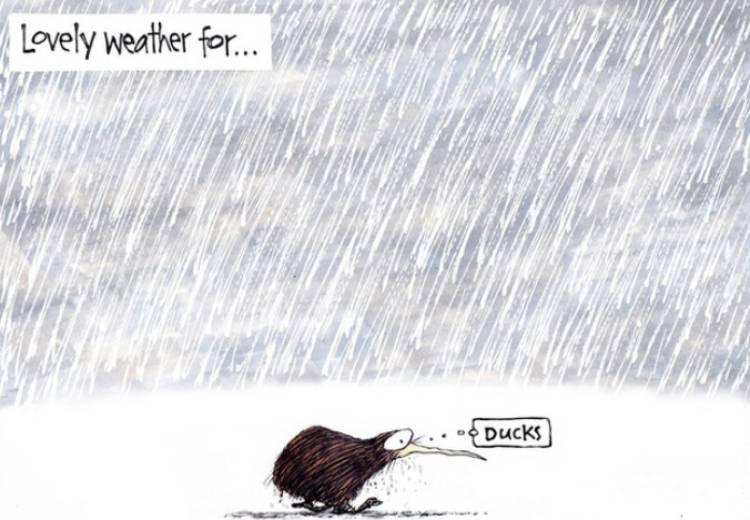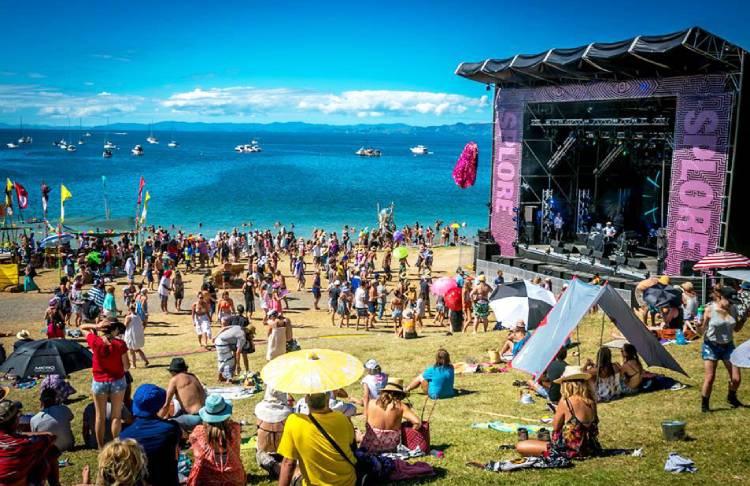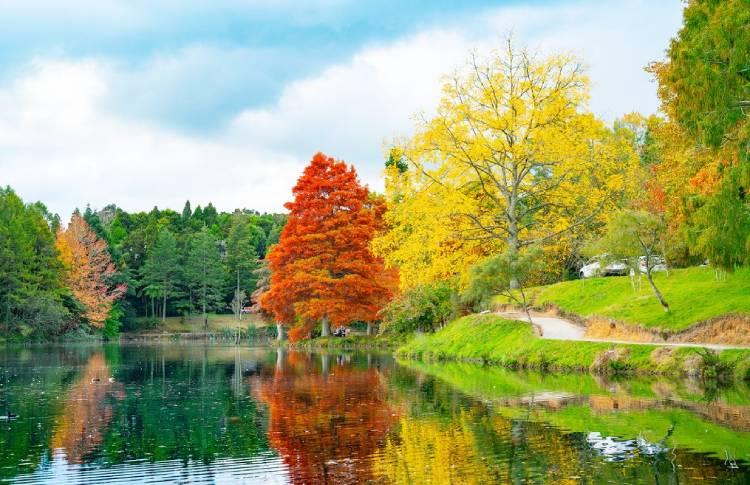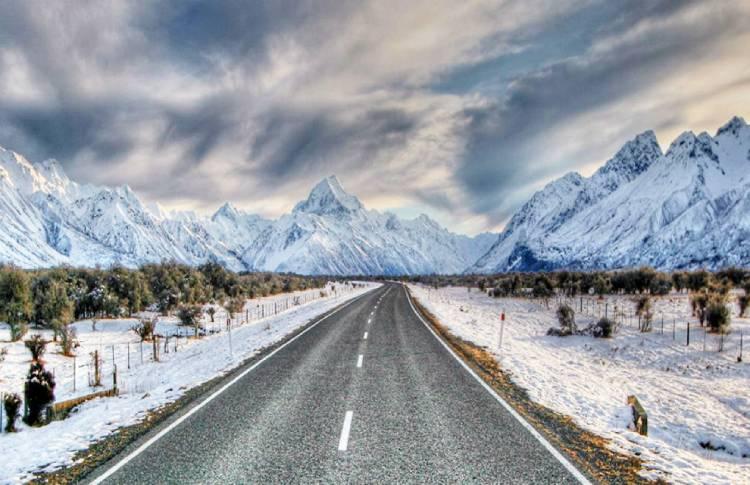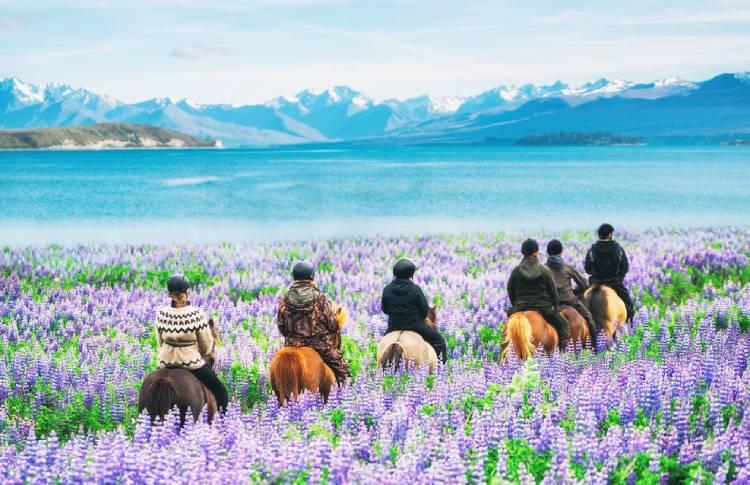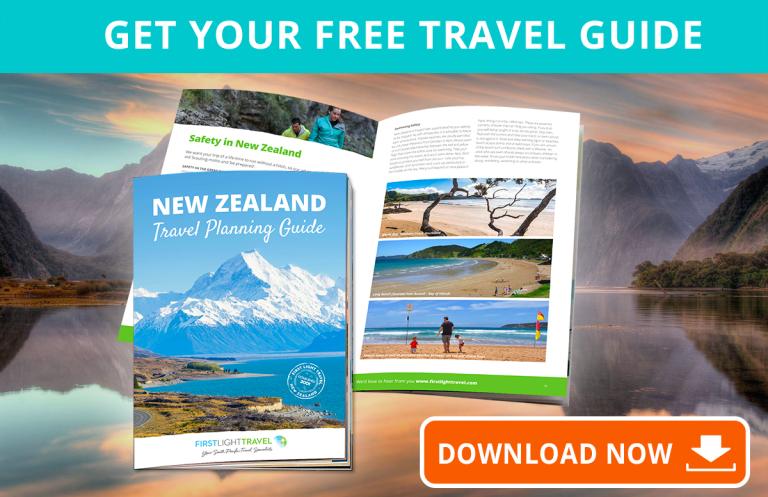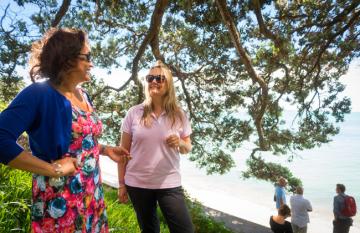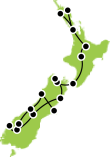
Want to know what the best time to visit New Zealand is?
Then you're in the right place, as we answer that question right here!
Let's get started . . .
Contents
- New Zealand’s Seasons, Weather & Climate
- Summer in New Zealand
- Autumn / Fall in New Zealand
- Winter in New Zealand
- Spring in New Zealand
- The Busiest Times To Travel To New Zealand
- Most Expensive Times To Travel To New Zealand
- The Quietest Month To Travel To New Zealand
- The Cheapest Month To Travel To New Zealand
When is the Best Time to Visit New Zealand?
- January is the best time to visit New Zealand for summer sun, while
- April’s autumn colours are simply stunning.
- August turns the South Island’s mountains into a snowy winter wonderland, and
- November is a standout for spring flowers and uncrowded hiking trails.
“Shoulder Seasons” (late spring and early autumn) offer a mix of warm weather and uncrowded attractions, with cheaper airfares and accommodation than travelling in high summer.
With so many great options, there is no "best" time for vacationing in New Zealand: it’s ridiculously beautiful no matter what time of year you visit.
So the real question is...
What is the best time for you to visit New Zealand?
Would you prefer to travel to New Zealand...
- When the weather is warm?
- When it's uncrowded and peaceful?
- When airfares are cheap?
Whatever your preferences are, we're here to help. In this blog we will cover:
- Weather conditions throughout the year
- Peak and off-peak travel times
- Budget considerations and
- Seasonal attractions you don't want to miss out on.
- Itineraries to help you make the most of each season.
Sit back and relax while we show you how to have an amazing time in New Zealand no matter what time of year you are visiting.
New Zealand’s Seasons, Weather & Climate
If you live in the Northern Hemisphere, you might be surprised to learn that in New Zealand you can...
- Ski from June to September
- Celebrate Christmas in the summer sunshine
- Eat your Easter eggs in Autumn
- Watch Spring lambs frolicking in October
Sounds confusing? Let us explain.
New Zealand Seasons
New Zealand has four distinct seasons.
- Spring: September, October and November
- Summer: December, January and February
- Autumn / Fall: March, April and May
- Winter: June, July and August
Think of them as the exact opposite to the Northern Hemisphere seasons. When it’s summer in Paris, it’s winter in Auckland. Autumn in New York is at the same time as spring in Wellington. And so on
New Zealand’s Weather & Climate
What is the weather like in New Zealand?
New Zealand’s temperatures are mild (even in winter), and while we do have moderately high rainfall, there is lots of warm sunshine too. The sunniest places in New Zealand receive around 2500 hours of sunshine per year: that’s around 1000 more than London!
New Zealand has two main islands: the North Island and the South Island. Generally speaking, the further south you travel, the cooler the temperature will be.
A “spine” of mountains runs down the centre of New Zealand, which further affects the temperature. The closer you are to the mountains, the cooler the temperature will be.
Even within each island, there can be huge variations in weather conditions. Here’s a breakdown:
North Island Climate
The North Island is known for being the warmer and wetter island. The Far North of New Zealand is known as the “Winterless North” because of its sub-tropical climate. You can enjoy pleasant temperatures in winter (around 16 degrees), as long as you’re prepared for the possibility of rainy days here and there.
At the same time, a winter holiday in Wellington, at the bottom of the North Island, would be noticeably chilly! (Luckily, many cities have wonderful winter festivals to tempt you even when it’s cold).
South Island Climate
The South Island is generally cooler and drier than the North… but it’s an island of extremes. It contains both the wettest parts of New Zealand (the West Coast region) and the driest (Central Otago). This is thanks to the Southern Alps mountain ranges - they act like a barrier, protecting the eastern side of the South Island from the more rainy weather of the west.
Which Island Is Better To Visit - North Or South?
Where are the sunniest places in New Zealand?
North Island:
- Sun-seekers should visit Hawkes Bay and the Bay of Plenty, areas which average around 2,200 sunshine hours per year. The top of the South Island regularly heads the list of the sunniest places in New Zealand.
South Island:
- The Nelson and Marlborough regions will keep your vitamin D levels topped up nicely, with around 2500 hours of sunshine per year.
Which places have the least sunshine? Towns at the bottom of the South island receive around 1600 hours per year. Which is still 100 more sunshine hours than London!
Do I need to wear sunscreen in New Zealand?
Yes, you will need sunscreen here even on cloudy days. New Zealand’s temperatures don’t seem high compared to many countries, but the sun here is much harsher. Our low levels of air pollution mean that UV rays are stronger and you will burn more quickly. We recommend using a SPF 30+ sunscreen that is water resistant and offers broad-spectrum protection.
Slap on some sunscreen, wear a hat and don’t forget your sunglasses - especially during the hottest part of the day (around 10am - 4pm) from September to April.
What about in winter? Yes you can still get sun burnt in winter. If you are planning to hit the slopes and go skiing or snowboarding during the winter months keep in mind that the snow reflects UV rays even when the temperature is cold so wear plenty of sunscreen and wear sunglasses or ski goggles.
Where are the wettest and driest places in New Zealand?
The South Islands West Coast is New Zealand's wettest region due to its position west of the Southern Alps. This area receives heavy and prolonged rain with annual totals exceeding 10,000mm. This rain produces stunning native forest and gives the area an extra wild and remote feel about it that is unique to this area.
Milford Sound is New Zealand’s wettest place, with a mean annual rainfall of 6,412 mm (252 in) each year. It’s on the southwest coast of the South Island. The rainforested West Coast region of the South Island (which includes Franz Josef and Fox Glaciers) is New Zealand’s wettest region.
Don't be put off by the rain! Milford Sound’s waterfalls are breathtaking when it rains, so we heartily recommend visiting even on a wet day. Read More about Milford Sound
Alexandra, in the Central Otago region of the eastern South Island, is generally the driest place in New Zealand. Annual rainfall is low on the East Coast of the South Island, and long dry summers are common.
A final word about weather…
New Zealand’s weather can be unpredictable at any time of year. The weather and temperature can change pretty fast… and then change back again a few hours later!
When booking a vacation in advance, you can’t predict exactly what kind of weather you’re going to get. But if your suitcase contains a raincoat, sensible shoes and a sweater (and cosy thermals in winter), you will be comfortable whatever the weather decides to do.
What to pack for a New Zealand Holiday
A Month-By-Month Guide To New Zealand Seasons
Summer in New Zealand (December, January, February)
New Zealand’s summers are sunny, but not too hot: with maximum temperatures around 25ºC, the long, light-filled summer days are ideal for exploring our Great Outdoors.
Summer in New Zealand is perfect for:
Beach holidays: swimming, sailing, surfing and splashing around with the kids.
New Year’s Eve: Enjoy Auckland’s spectacular fireworks or see the world’s first sunrise of the year in Gisborne… without having to shiver in the cold.
Celebrating New Zealand Culture: Join the locals for Waitangi Day celebrations on February 6 - it’s our national day and a huge New Zealand holiday.
Festivals and Events Galore: The New Zealand Rugby Sevens tournament, the World Buskers Festival and the Rhythm and Vines music festival are just some of the many annual summer festivals to tempt you.
Local Produce: There is nothing tastier than freshly picked Otago stone or pip fruit. Grab some from a roadside stall or pick your own from a local farm - an awesome family activity.
City breaks: with everyone heading to the coast in summer, cities like Wellington, Auckland and Christchurch are often less crowded.
Summer in New Zealand: Month-by-month
December
It’s early summer, the weather is warming up and the days are getting longer! If you have never celebrated Christmas in the sunshine, a classic Kiwi beach bbq is the way to go. Book as early as you to beat the high demand for Christmas and New Year accommodation.
January
It’s New Zealand’s warmest month, but there are plenty of ways to beat the heat. Jet boating, white water rafting, and swimming with dolphins are just a few great ideas. Coastal national parks and lakeside beauty spots will cool you down while wowing you with scenic views you’ll never forget.
February
The school year starts in February and the crowds disperse from New Zealand’s best-loved family holiday hotspots. The later in February you travel, the quieter it gets… and you won’t miss out on warm temperatures, glorious sunshine and endless summer vibes.
Summer Temperatures in New Zealand
Summer average temperatures range from 50 - 77 ºF (10-25 ºC). The further north you go the hotter it gets. The most settled time in terms of weather is February.
Summer Itinerary suggestion: 10-Day Lake District, Wild Rivers & Coastal Treats
Autumn / Fall in New Zealand (March, April, May)
During Autumn in New Zealand you can expect sunny days with temperatures milder than in summer - fantastic weather for hiking and exploring. The nights will be cool, so sweaters are essential. Weather-wise, early autumn is a wonderful time for a New Zealand vacation.
Autumn / Fall in New Zealand is perfect for:
- Fall Colours: Seeing the forested hillsides around Queenstown decked out in vivid red and gold leaves.
- Hooking a trophy fish: Salmon fishing in the South Island, and big game fishing in the North
- Stargazing: Look to the heavens in our International Dark Sky Reserves around Lake Tekapo & Mt Cook
- Two-wheeled wine tours: Pedal through picturesque wine country in the Hawkes Bay, Marlborough & Otago regions. Don’t forget to stop for a taste!
- Great Walks: Cross the Routeburn Track or Tongariro Alpine Crossing off your bucket list
Autumn / Fall in New Zealand: Month-by-month
March
Early Autumn in New Zealand is similar to late summer - the temperatures remain warm even as the leaves are turning golden on the trees. The nights are cooler and the days are shorter, but look on the bright side: you won’t have to get up as early to catch a beautiful Milford Sound sunrise! New Zealand’s world-class Great Walks hiking trails are a joy at this time of year.
April
Base yourself around Queenstown, Arrowtown and Central Otago in April and you’ll be wowed by the autumn foliage. It’s the perfect time for a Central Otago wine tour, surrounded by magical views of red-and-gold forests in all their glory.
May
In May the temperature drops, rainfall increases, and winter is on its way. Don’t be put off: tourist hotspots will be super quiet, and May is the cheapest month for airfares to New Zealand! To minimise your chance of rainy days, consider a South Island road trip: Auckland receives around twice as much rain as Christchurch during May.
Autumn / Fall Temperatures in New Zealand
Temperatures are still averaging a high of 68 ºF (20 ºC), making autumn in the great Kiwi outdoors heaps of fun.
Sample Autumn Itinerary: 11 Day Wine and Scenic Highlights of New Zealand
Winter in New Zealand (June, July, August)
Winter offers a surprising variety of holiday options in New Zealand. Head Far North to the Bay of Islands for a warm coastal escape, or embrace the chill with a winter vacation among the snow-topped mountains around Queenstown and the South Island.
Winter in New Zealand is perfect for:
- Thermal pools: Soaking in our naturally-heated thermal hot pools
- Southern Lights: Spotting the Aurora Australis in the winter sky
- Snow Sports: Skiing, snowboarding and exploring New Zealand’s glacier regions
- Tramping: Discovering the trails of the “Winterless North”
- An Epic Train Journey: The TranzAlpine Railway between Christchurch and Greymouth crosses the snowy Southern Alps with dramatic mountain views.
Winter in New Zealand: Month-by-Month
June
Time to hit the slopes: June is when the ski season opens and the snow resorts around Queenstown, Wanaka, Christchurch and Mt Ruapehu spring to life. The temperatures may have dropped, but the festival season is heating up: Matariki (Maori New Year), the Queenstown Winter Festival and the Oamaru Steampunk Festival are some of the many awesome events to get involved in.
July
Ski season is in full swing, but if the slopes aren’t your thing, you will still love the wintery South Island landscapes dusted with snow. It’s a good time to discover the magnificent Franz Josef or Fox Glaciers: the West Coast weather is more stable during winter, so flying conditions are better for scenic flights and heli-hikes.
August
August is regarded as the best month for snow sports in New Zealand if you’re coming from overseas. August has the highest chance of a decent snowfall (an important consideration if you’re booking several months in advance). It’s also a wonderful time for winter festivals, with Wellington On A Plate for foodies, New Zealand Fashion Week for style junkies, and the Bay of Islands Jazz & Blues Festival for top tunes.
Winter Temperatures in New Zealand
Temperatures during winter range from 34-48ºF (1-16 ºC), but it does depend on where you are in the country. Up North and near the coastline it’s a lot warmer.
Winter Itinerary Example: 13 Day South Island Winter Adventure Circuit
Spring in New Zealand (September, October, November)
In spring New Zealand is a paradise for outdoor-lovers. Take advantage of uncrowded hiking trails to admire the spring flowers blooming, lambs bouncing in the fields, and mountains still capped with snow.
Spring in New Zealand is perfect for:
- White water rafting: The rivers are in full flow, thanks to the melting winter snow
- Milford Sound: See the Sound’s waterfalls at their finest (again, thanks to the melting snow)
- Late-season ski-ing: By September the crowds are gone and the slopes are quieter.
- Spring flowers: See New Zealand’s lush botanic gardens in full bloom
Spring in New Zealand: Month-By-Month
September
September still has a chill in the air, but the early spring sunshine can’t be beaten for outdoor adventures. Abel Tasman National Park lies within the sunniest part of New Zealand. New Zealand’s most popular national park is near-deserted at this time of year, and you’ll have the stunning Coast Track virtually all to yourself.
October
Spring has well and truly sprung, and October is the prime time for admiring New Zealand’s flora and fauna. At this time of year you can watch Little Blue Penguins in Oamaru, swim with seals in Kaikoura, visit the world’s largest mainland gannet colony at Cape Kidnappers, and see irresistible baby lambs in the fields as you pass by.
November
November in New Zealand can feel like summer, with balmy temperatures and more sunshine hours to pack your sightseeing into. The North Island’s rainiest months of the year have passed now, so why not make it a feature of your itinerary? Discover Coromandel beaches, white water rafting in Rotorua, magical Hobbiton, glow worms in Waitomo, and picturesque Taupo - before the summer peak season hits in December.
Spring Temperatures in New Zealand
Spring weather can be unpredictable. Temperatures can range between 67-41 ºF (5-19ºC). There can be crisp, clear days, or morning frost and showers.
Sample Spring Itinerary: 17 Day Easygoing Self Drive Itinerary
The weather isn’t the only thing you need to consider when planning your New Zealand vacation. Here are a few other factors...
More Things To Consider When Planning Your Trip
The Busiest Times To Travel To New Zealand
Unsurprisingly, midsummer (late December to early February) is the busiest season to travel to New Zealand. Who doesn’t want to have fun in the sun?
But there are some particularly busy peak periods that you need to be aware of before choosing the dates for your NZ dream vacation...
National Holidays
Christmas, New Year, Easter, and Waitangi Day: around these times, you’ll be competing for accommodation with Kiwis enjoying a well-deserved public holiday. These are popular times to travel, and major tourist attractions from Hobbiton to Milford Sound can be crowded.
School Holidays
School holidays consist of three half-term breaks - one around Easter, one in late June to July, and one in late September to October. The summer holiday lasts for 6 weeks, beginning in December. Book early if you want to travel around these times.
Sporting Events & Concerts
New Zealand's population is small, but when there's a major event or concert (like an All Blacks rugby match), even big cities like Auckland can run out of accommodation as tens of thousands of fans flock to see their heroes in action...
Ski Season
In late June and July, when the schools are on holiday, you’ll struggle to find accommodation around the main snow destinations like Queenstown and Wanaka if you don’t book early.
Most Expensive Times To Travel To New Zealand
Midsummer, school holidays, and national holidays (and ski season in places like Queenstown) are the most expensive times to travel to New Zealand, due to extremely high demand from both domestic and international holidaymakers.
The Quietest Month To Travel To New Zealand
Late Autumn / Fall is generally the quietest time to travel to New Zealand. The late autumn weather can be chilly and rainy days are more likely. But New Zealand weather is famously unpredictable, and what we consider “chilly” in New Zealand is still considerably warmer than an autumn day in most of Northern Europe!
The Cheapest Month To Travel To New Zealand
May is the cheapest month to travel to New Zealand. You’ll save a lot of money on everything from airfares to accommodation if you visit in May.
Many activity providers offer discounts during the quieter months, but some weather-dependent activities shut down for the winter. If you have your heart set on a Milford Sound overnight cruise, for example, they only operate between October and May. So check before you book.
Best Time To See The Southern Lights (Aurora Australis) In New Zealand
Autumn and winter (March to September) are the best times of year to glimpse the Southern Lights in New Zealand. In theory you can see them at any time of year. But the long, dark winter nights give you a better chance of witnessing this elusive and natural light show. Lake Tekapo, Aoraki/Mt Cook and Stewart Island are popular destinations for aurora-hunters.
Even on the darkest winter nights, there is no guarantee that the Southern Lights will be visible when you visit. But since winter is a beautiful time to visit the South Island anyway, you won’t have a wasted journey!
In Conclusion...
So what have we learned? Here are some key takeaways:
- If you want to beat the crowds, the best time to come is during “Shoulder Seasons” - spring or autumn.
- If you’re on a tight budget, the best month to come to New Zealand is May, when flights and accommodation are cheapest.
- Book as early as possible if you’re travelling to New Zealand in high summer or during other peak periods.
- If you want sunshine, the best time to visit New Zealand is late spring to early autumn.
- If you want snowy landscapes, come and see us between June and September.
But If you want an unforgettable holiday, you can come to New Zealand at any time of year. We look forward to welcoming you
Recent Posts
Blog Categories
Blog archives
- February 2025 (3)
- January 2025 (6)
- December 2024 (12)
- November 2024 (3)
- October 2024 (2)
- July 2024 (2)
- May 2024 (12)
- April 2024 (2)
- March 2024 (2)
- January 2024 (2)
- November 2023 (10)
- October 2023 (4)
- August 2023 (1)
- May 2023 (2)
- April 2023 (2)
- March 2023 (17)
- February 2023 (4)
- January 2023 (4)
- December 2022 (11)
- November 2022 (7)
- October 2022 (1)
- May 2022 (1)
- March 2022 (3)
- February 2022 (3)
- January 2022 (1)
- December 2021 (1)
- August 2021 (1)
- June 2021 (1)
- May 2021 (2)
- February 2021 (1)
- August 2020 (1)
- July 2020 (1)
- May 2020 (1)
- April 2020 (1)
- March 2020 (1)
- January 2020 (1)
- December 2019 (1)
- November 2019 (1)
- October 2019 (1)
- September 2019 (1)
- August 2019 (5)
- July 2019 (2)
- June 2019 (1)
- May 2019 (3)
- April 2019 (1)
- March 2019 (1)
- February 2019 (1)
- January 2019 (1)
- December 2018 (1)
- November 2018 (1)
- September 2018 (1)
- August 2018 (1)
- July 2018 (1)
- June 2018 (1)
- May 2018 (1)
- April 2018 (1)
- March 2018 (1)
- February 2018 (1)
- January 2018 (1)
- December 2017 (1)
- October 2017 (1)
- September 2017 (1)
- August 2017 (1)
- July 2017 (1)
- June 2017 (1)
- May 2017 (1)
- April 2017 (1)
- March 2017 (1)
- February 2017 (1)
- January 2017 (1)
- December 2016 (1)
- November 2016 (1)
- October 2016 (1)
- September 2016 (1)
- August 2016 (1)
- July 2016 (1)
- June 2016 (1)
- May 2016 (1)
- April 2016 (1)
- March 2016 (1)
- February 2016 (1)
- January 2016 (1)
- December 2015 (1)
- November 2015 (1)
- October 2015 (1)
- September 2015 (1)
- August 2015 (1)
- July 2015 (1)
- June 2015 (1)
- May 2015 (1)
- April 2015 (1)
- March 2015 (1)
- February 2015 (1)
- January 2015 (1)
- December 2014 (1)
- November 2014 (1)
- October 2014 (1)
- September 2014 (1)
- July 2014 (1)
- June 2014 (3)
- May 2014 (1)
- April 2014 (1)
- March 2014 (1)
- February 2014 (1)
- January 2014 (1)
- November 2013 (15)
- October 2013 (1)
- September 2013 (1)
- August 2013 (1)
- July 2013 (1)
- May 2013 (1)
- April 2013 (1)
- March 2013 (1)
- February 2013 (1)
- January 2013 (1)
- December 2012 (1)
- November 2012 (2)
- October 2012 (2)
- September 2012 (2)
- August 2012 (2)
- July 2012 (2)
- June 2012 (2)
- May 2012 (2)
- April 2012 (3)
- March 2012 (2)
- February 2012 (2)
- January 2012 (3)
- December 2011 (1)
- November 2011 (1)
- October 2011 (2)
- September 2011 (1)
- August 2011 (1)
- July 2011 (1)
- June 2011 (1)
- May 2011 (1)
- April 2011 (1)
- March 2011 (1)
- February 2011 (1)
- January 2011 (1)
- December 2010 (1)
- November 2010 (1)
- October 2010 (1)
- September 2010 (1)
- August 2010 (1)
- July 2010 (1)
- June 2010 (1)
- May 2010 (1)
- March 2010 (1)
- February 2010 (1)
- January 2010 (1)
- December 2009 (1)
- November 2009 (1)
- October 2009 (1)
- September 2009 (1)
- August 2009 (1)
- July 2009 (1)
- June 2009 (1)
- May 2009 (1)
- April 2009 (1)
- March 2009 (1)
- February 2009 (1)
- January 2009 (1)
- December 2008 (1)
- May 2005 (1)


